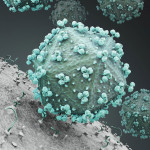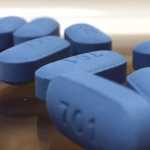Researchers have found a new site on HIV’s surface that is vulnerable to a powerful antibody, a discovery that could lead to novel developments in the treatment, prevention and vaccine fields. Publishing their findings in Nature, researchers at the National Institutes of Health found that an antibody called 35O22 binds to the virus at a site straddling two proteins, gp41 and gp120, that stick out of the virus.
The 35O22 antibody prevents 62 percent of all known strains of HIV from infecting cells in a laboratory setting. The antibody is also highly potent, with a relatively small amount needed to neutralize the virus. The NIH researchers found that 35O22-like antibodies were common among a cohort of HIV-positive people who had developed antibodies that were able to ward off a broad swath of HIV strains. They believe that this finding suggests that vaccines might have better success at eliciting 35O22 than other, less common, broadly neutralizing antibodies (BNAs).
The researchers believe a vaccine, or a prevention or treatment regimen, that elicits 35O22-like antibodies along with a few other BNAs could prove effective against the vast majority of HIV strains found around the world.
To read the study abstract, click here.
To read the NIH press release, click here.
Advertisement
Advertisement
Advertisement






1 Comment
1 Comment